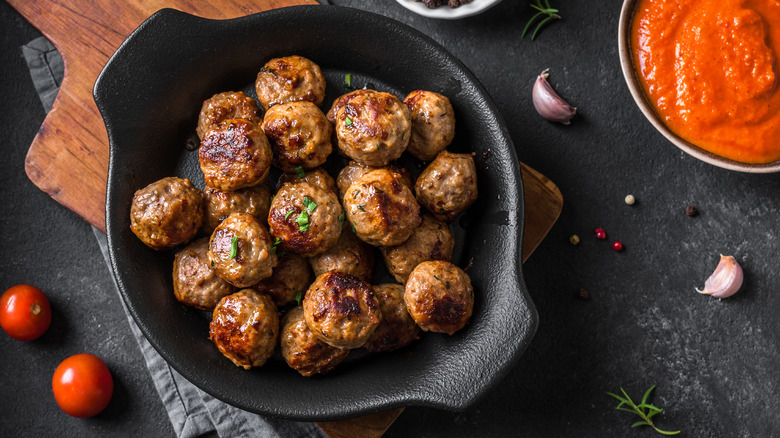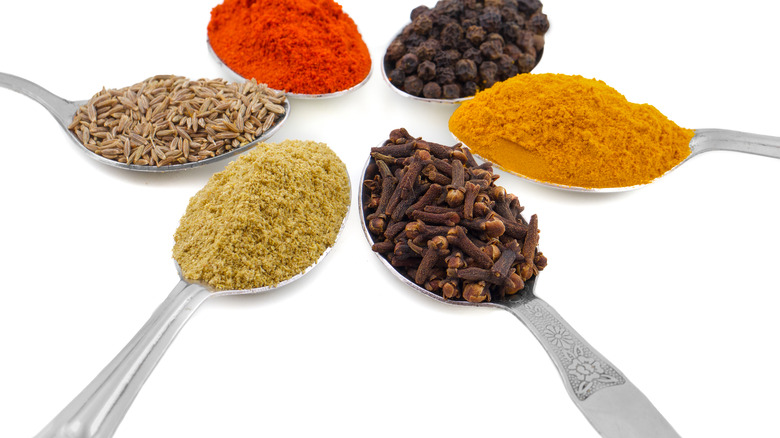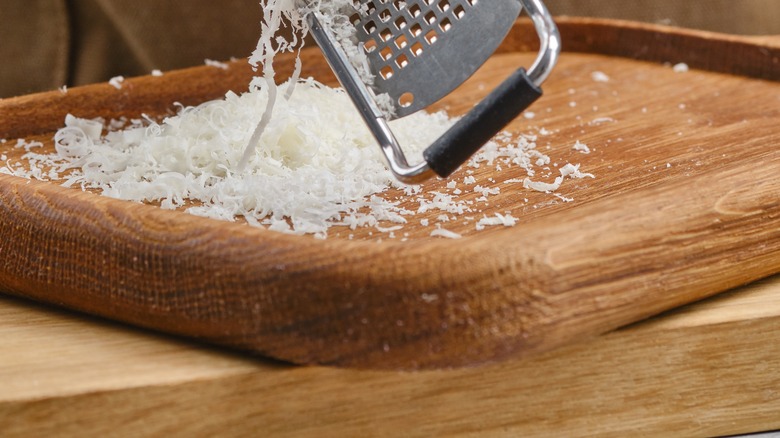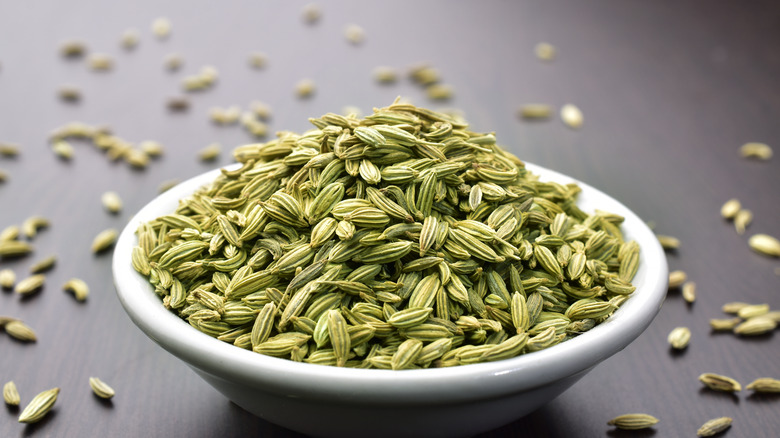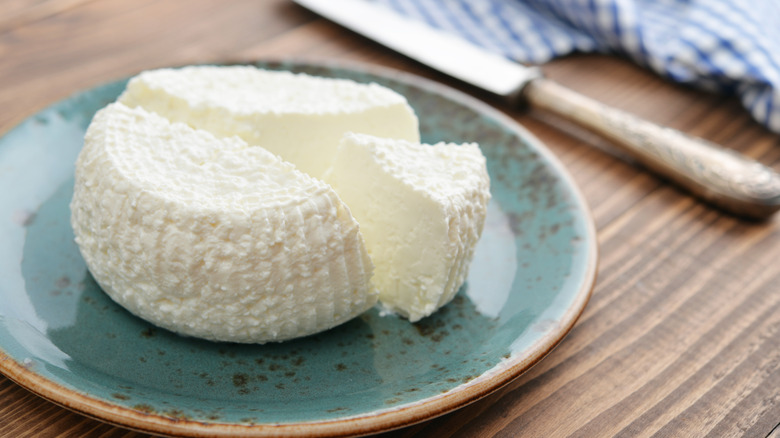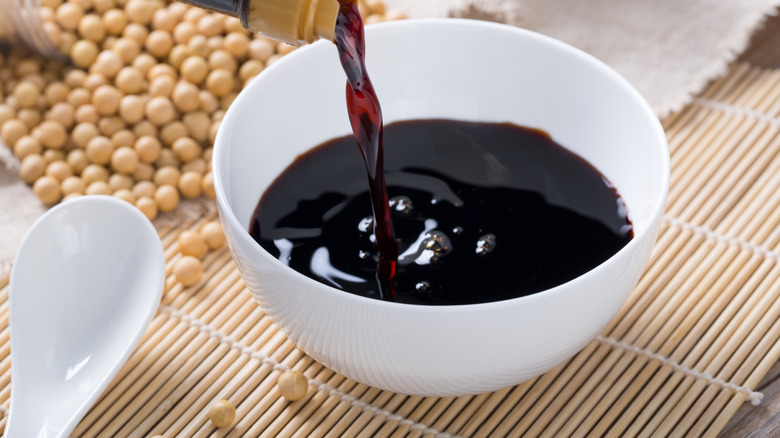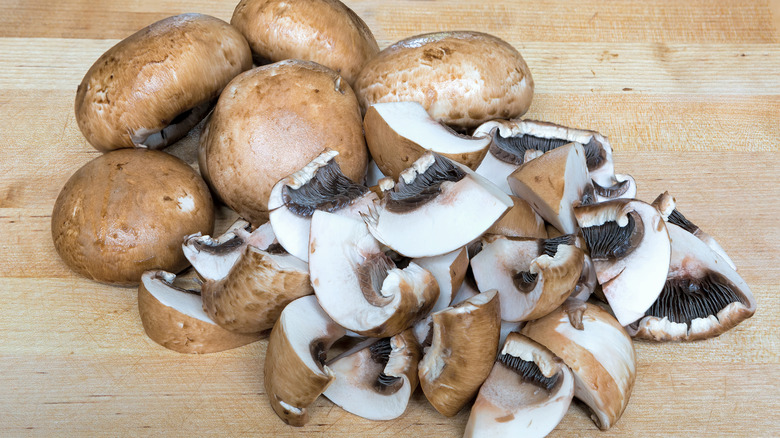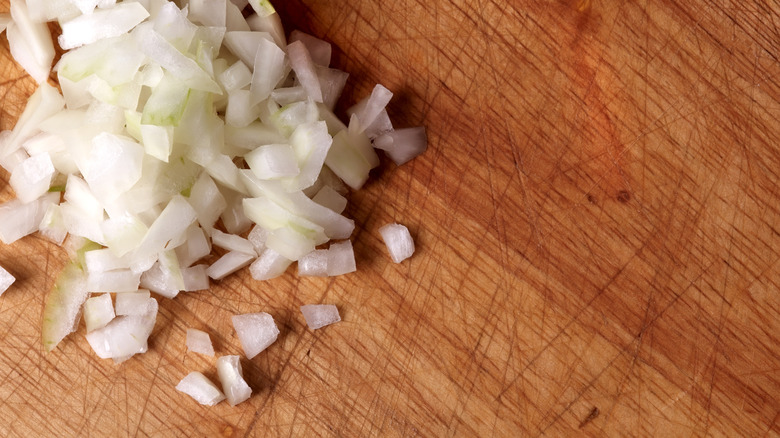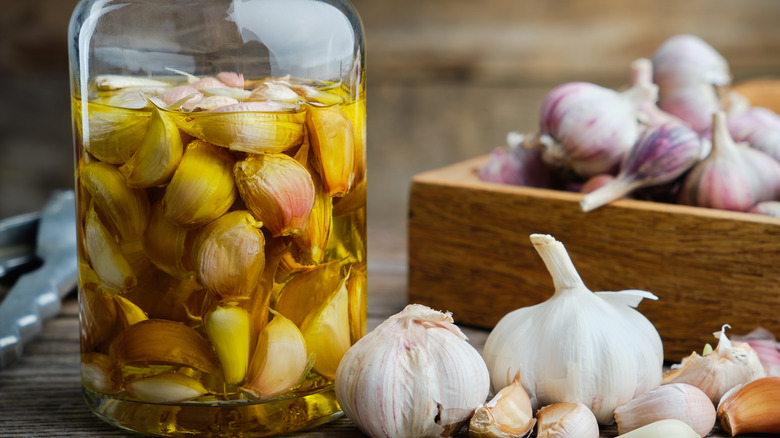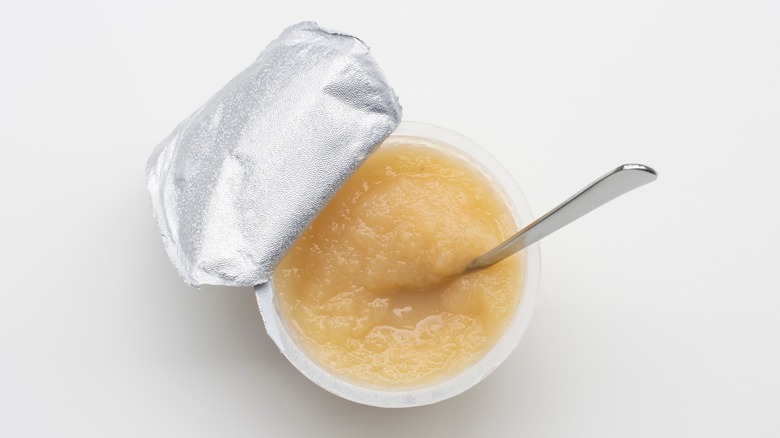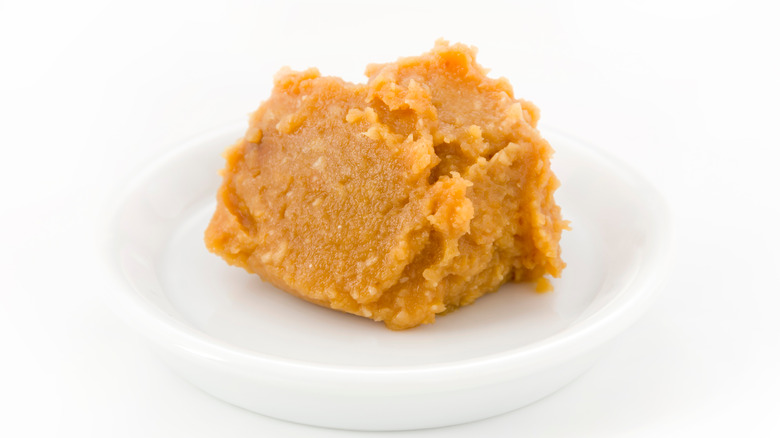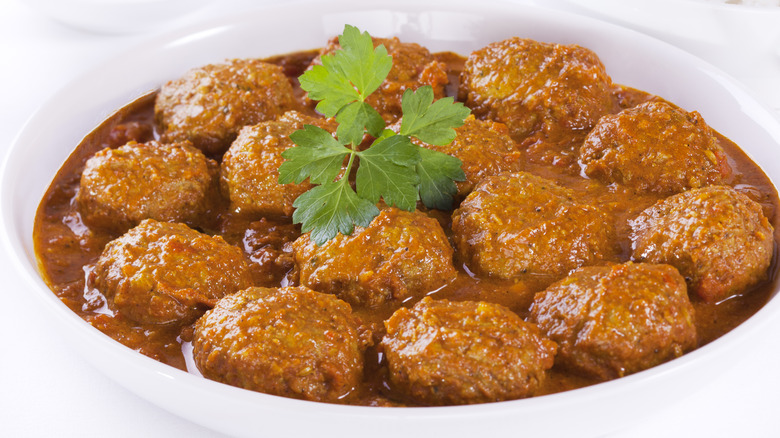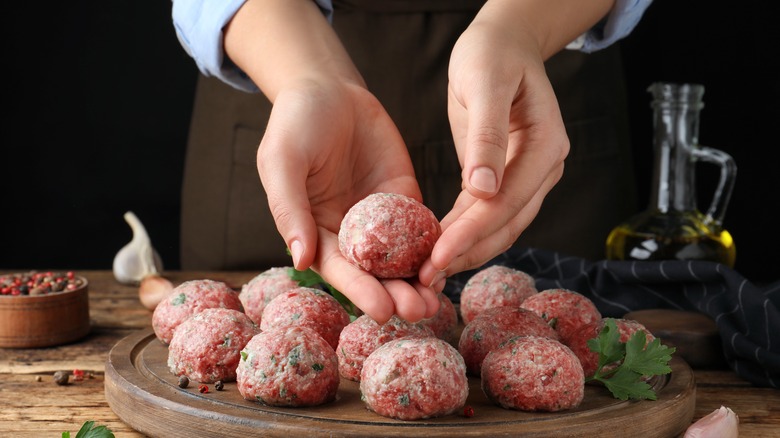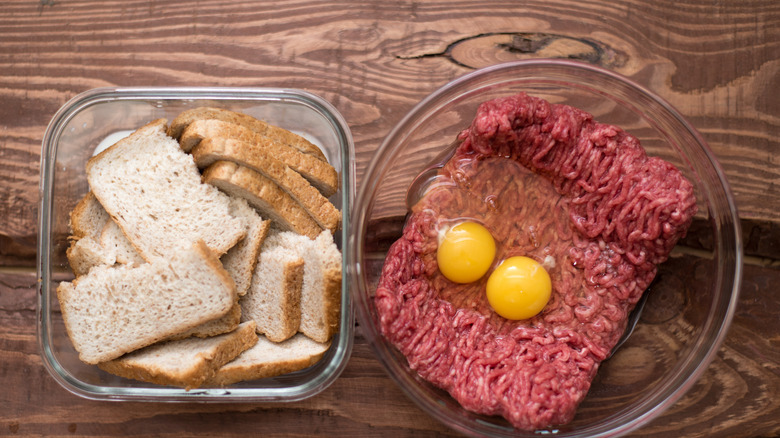15 Ways To Add More Flavor To Meatballs
Meatballs are an important staple for a Sunday night dinner that all home cooks should know how to prepare. One of the best parts about meatballs is that every person has a different variation of how to prepare the classically Italian dish. You might be a stickler for fresh basil, rosemary, and oregano, or can appreciate the utility of dried herbs in your recipe instead. Or, you may believe pork-and-beef mixes rein supreme — while others are more adventurous with ingredients like minced lamb or mutton.
Besides making sure you have the perfect set-up to make meatballs, you should also consider what kinds of ingredients you add to them to amp up the flavor. Like other dishes, you should always try to play with the main five main flavors — sweet, salty, sour, bitter, and umami — to engineer the perfect flavorful meatball. Experimenting with flavors, techniques, and ingredients may bring you into uncharted territory, but we can assure you that the adventure will be worth it.
Increase the heat with spicy sausage
Adding a small portion of spicy Italian pork sausage is an easy way to increase the complexity and heat of your meatballs. If your grocer or butcher just sells the filling, opt for that. Otherwise, you can slice open sausage links and remove the casing before combing with your other meat choices. The Italian flavors of the sausage, which can include dried herbs, complement the traditional meatball profile, while the red pepper flakes will a touch of fire.
If you want to boost the flavor of your meatballs with spicy meat, you might consider another type of sausage — Mexican chorizo. Unlike cured Spanish chorizo, Mexican chorizo is kept raw and seasoned with a blend of cumin, chili powder, dried Mexican oregano, cinnamon, cloves, smoked paprika, and sweet paprika. While you can make homemade chorizo with either beef or pork sausage, we recommend using the pork blend for its richer flavor.
Use a Mediterranean spice blend
The standard meatball spices — oregano, basil, and the catch-all Italian seasoning can get boring. If you want to prepare a remarkable Moroccan meatball recipe, you'll need to get a little more serious with your spices. These meatballs are flavored with an intricate blend of cumin, paprika, chili powder, and turmeric. All of these spices are added to the meatballs with ground beef, fried onion pieces, and binders. For a stronger flavor profile, you could incorporate the seasoning into the sauce as well. We recommend adding a hint of brown sugar to the sauce to help curb some of the acidity from the tomatoes and heat from the spices.
You can pair your spicy meatballs with a delicious crusty piece of bread or a starchy side of quinoa, pasta, or rice. Make a large batch and freeze these meatballs overnight and defrost them in the refrigerator as you need them.
Grate in some parmesan cheese
Cheese makes everything better — including meatballs. One of celebrity chef Ina Garte'ns unusual tricks for more flavorful and juicy meatballs is adding over half a cup of freshly grated parmesan into her meat blend (via YouTube). The cheese adds a subtle sharpness to the meatballs without disrupting the texture of the meatballs. To help keep her meatballs moist, Garten also adds a splash of water to her meatball mix to help keep the meatballs moist as they cook.
Grating fresh Parmesan to your meatballs for a subtle tangy flavor and a touch of umami. If you're looking for a more subtle flavor, we recommend trying Grana Padano, another type of dry cheese. Grana Padano has a similar light yellow hue to Parmesan and a granulated texture that mixes in easily with the meatballs. You can also add Pecorino Romano, a cheese with a slightly shorter aging time that results in a fresher, more mild flavor than Parmesan. Regardless of the type of cheese you use, don't be afraid to add an extra coating on top of whatever sauce you pair with your meatballs.
Bring fennel seeds into the mix
Fennel seeds are a unique spice that you may not have ever used in the kitchen. Fennel has a less pungent flavor than anise and is derived from an entirely separate plant. Fennel seeds are best reserved for savory recipes while anise can be used for sweet applications in conjunction with warming spices like cinnamon and nutmeg.
We recommend adding some fennel seeds to your next Swedish meatball recipe. The woody and slightly licorice-like flavor pairs well with the savoriness of the tomato sauce and the meatiness of the pork or beef. Since fennel seeds are a powerhouse of flavor, it is best to add trace amounts of the seasoning to your meatballs. Recipes can range from using ¼ of a teaspoon to 1 whole teaspoon for every 2 pounds of meat used. If you want a more aromatic fennel experience, you can toast the seeds in a skillet to release some of the oils from the seeds before you add them to your meatballs.
Keep it tangy with ricotta cheese
Ricotta is the perfect cheese in a meatball recipe for both moisture and flavor. It technically isn't considered cheese because it's a byproduct of the cheesemaking process; cheesemakers add acid to boiling milk to cause the curds and whey to separate. The whey is then combined with another acid, heated, and strained to produce ricotta. The curds are used for other types of cheeses like mozzarella.
When the cheese is added to the meatball mixture, it leaves a distinctively creamy flavor and can help your meatballs stick together as a binding agent. The secret ingredient for Michael Symon's meatballs happens to be ricotta, and he recommends using one cup of the cheese (preferably whole milk) for every 1½ pounds of ground meat (via TODAY). Ricotta boosts the fat content of the meatballs too, which is especially important if you're working with a leaner blend of ground beef or ground turkey, which can be a little too dry for meatballs otherwise.
Add a splash of soy sauce
Soy sauce is the secret salty ingredient you didn't know you needed in your meatballs. You can substitute a small portion of the water in your recipe for soy sauce for a blast of salty flavor. Adding soy sauce to your meatballs should always be done in small portions because too much liquid will upset the hydration balance of your meatballs and possibly make them too salty.
There are several different types of soy sauce to choose from. Japanese soy sauce, called shoyu, tends to be the standard in Asian restaurants and grocery stores with popular brands like Kikkoman readily available. Since shoyu contains both wheat and soybeans, as well as a lot of sodium, it is not suited for all dietary preferences. Chinese soy sauce, in comparison, is heavier on soybeans and lighter on wheat. This soy sauce variety has a more prominent salty flavor with some slightly sweet undertones.
Blend with mushrooms
Mushrooms can provide a complex umami flavor to your meatballs — as well as a healthy dose of vitamins and minerals. You'll first want to chop your mushrooms into fine pieces and cook them on a stove until they release their moisture. Then strain the mushrooms and mix the pieces directly into your meat mixture. If you forget to cook them beforehand, you'll find that your meatballs will be especially moist due to the water content in raw mushrooms and potentially fall apart.
There are several different types of mushrooms you can add to your meatballs depending on the flavor profile you enjoy. Baby Bellas (criminis) and white button mushrooms are two of the mildest types of mushrooms and are often readily available in grocery stores. Maitake, also called "hen of the woods," have a deeper, more meaty flavor but are pricier and less common in general supermarkets. For cost and availability, shiitake mushrooms are the middle ground between the maitake and the criminis and have a rich, umami flavor after they're cooked.
Improve the texture with chopped fresh vegetables
Chopped garlic and onions don't have to be relegated to the hearty gravy you're simmering on meatball night. These are two special ingredients that can add an organic undertone to your meatball blend. You'll need to cook these ingredients down before you add them to your meatballs; this step will even out the texture of your meatballs and ensure that they do not release too much water to cause them to fall apart.
If you notice your meatballs falling apart, you should also examine the size of your non-meat ingredients. Leaving large chunks of onion or pepper in your meatballs means that the binder and the meat won't stick together and keep the shape of the meatball. Besides finely dicing, you should also avoid the meatball mistake of including too many vegetables in your meatball — it is a "meat" ball after all.
Sear the meatballs in a pan before baking
Improving the flavor of your meatballs doesn't always have to mean adding new ingredients. It can also mean changing the way you cook them. When you give your meatballs a chance to sear before you bake them, you're opening up the opportunity for the Maillard reaction to occur. When the proteins and sugars interact with the heat, you'll get a mild, caramelized flavor that is much more profound than just baking your meatballs and pouring a layer of sauce over them. We recommend using a cast iron pan to sear your meatballs — the iron retains heat well and produces a perfectly delicious sear.
After you've seared your meatballs, you should avoid drowning them in your favorite marinara sauce and possibly overcooking the meatballs. You should only cook your meatballs until they reach an internal temperature of 160 F (via the University of Illinois Extension).
Swap in infused olive oil
Olive oil is an important ingredient for sautéing vegetables in a classic Italian meatball recipe. And one way to take olive oil a step up is by using an infused olive oil instead of a plain one. Chef George Zakarian uses rosemary-infused olive oil to sear his meatballs; he believes the meaty flavor contrasts the organic flavor of the herb well (via TikTok).
There are several methods to infuse olive oil at home. Simmer your oil and aromatics on a stove for up to 15 minutes — just be sure not to let the oil boil to disrupt the flavor of the infusion. Once the oil is completely cooled, you can strain it and store it in an airtight container. Alternatively, you can leave your fresh herbs and oil in a bottle in the fridge for about a week. For herb-infused olive oil, you should leave it in a cool, dry place for about a month. If you use fresh herbs to infuse your olive oil, you should use the infusion within a week.
Add a scoop of unsweetened applesauce
Every savory meatball needs a bit of a sweet flavor. Although it might seem unusual to use applesauce as an ingredient in your meatballs, the moistness and sweetness of the applesauce can curb the saltiness of your meatballs and balance out the flavors. You'll need about ⅔ of a cup of unsweetened applesauce for every 1½ pounds of ground meat used in your recipe. According to Tasty, adding applesauce to meatballs may also have a positive impact on their texture. The meatballs made with applesauce tasted much lighter and were moister than the version made without applesauce; the reviewers even likened them to turkey meatballs.
You should always have applesauce in your pantry — and not just for making meatballs. You can use applesauce as a substitute for oil and eggs in boxed cake or brownie mix or make seasonally-inspired apple butter with cinnamon and warming spices.
Use miso paste for an umami flavor
Soy sauce is just the start of including Asian ingredients in your meatballs. Miso is made by cooking soybeans with salt and a mold mixture known as koji. The mold can be propagated on different kinds of grains like rice, barley, or soybeans. The result is a flavor more complex and intense than soy sauce.
There are several different types of miso you can use in your meatball recipe. White miso (also called Shiro) has the mildest and least salty flavor of the miso types. Red miso is on the other end of the spectrum with a much deeper complexity and stronger salty flavor than the other miso types.
If you've never made meatballs with miso before, we recommend starting with the white miso for the mildest flavor before moving up to the red miso or the hybrid yellow miso that tastes like a combination of both of the miso varieties. You only need a couple of tablespoons of miso paste for your miso recipe.
Make a Sicilian-style meatball with pine nuts and currants
Sicilian-style meatballs are unlike any meatballs you've ever had before. The two ingredients that set Sicilian meatballs apart from standard Italian meatballs are pine nuts (pignoli) and currants. The pine nuts add a bit of a crunch while the currants provide a fruity undertone to the meatball.
Pine nuts can be found in the baking aisle of your grocery store, but what about currants? These fruits are slightly more elusive, so many Sicilian meatball recipes allow you to swap raisins in instead. Currants are made from small Black Corinth grapes and are exclusively sold under the label "currants" in grocery stores. "True currants," which are almost always sold fresh, are made from berries like red currants, black currants, and white currants. Alternatively, raisins are only made with dried white grapes. You can substitute the two using a 1-to-1 ratio in your Sicilian meatball recipe.
Always use high-fat meat
One of the biggest mistakes people make with meatballs is not using the right meat-to-fat ratio. If you're trying to cook "healthy" meatballs, you might be inclined to use low-fat meat like turkey or lean ground beef. However, these types of meat do not have enough fat to ensure the meatball sticks together and develops an unctuous texture. A ratio of 70% meat to 30% fat is the sweet spot. Pork contains about 40% fat, and 100% lean beef contains very, very little fat. Therefore, if you combine these two types of meat correctly, you'll get the perfect amount of fattiness.
If red meat isn't your preference, not to worry. You can make juicy poultry meatballs by using dark-meat chicken or turkey and grind the meat with the skin on. This will bring the fat content up and help you achieve the perfect fatty flavor ratio in your meatballs.
Soak your bread in milk, not water
If you want meatballs that stick together, you first have to make sure that you soak your bread in milk rather than water. According to Scott Conant, using bread in your meatballs rather than the status quo scoop of breadcrumbs is the key to a flavorful meatball. Conant recommends using the traditional Italian Panna method to prepare your bread. This involves soaking the bread in milk or cream for a few seconds before squeezing out the liquid. This helps the other ingredients in the meatball stick together as a binder in the meatballs.
While soaking your choice of bread in water may help keep your meatballs moist when you sear them, it doesn't do anything for the flavor of your meatballs. The cream (or whole-fat milk) is a much more decadent option for soaking your bread which will result in a much creamier flavor.
